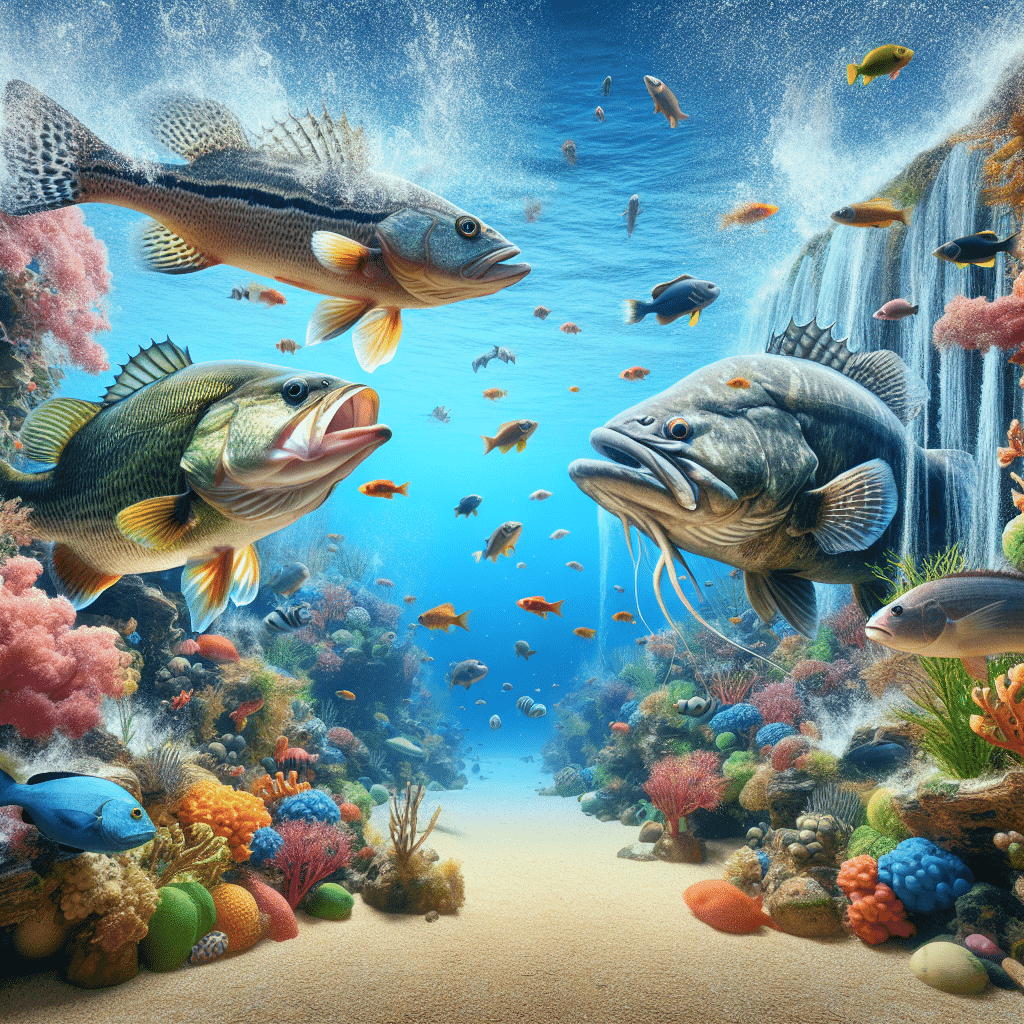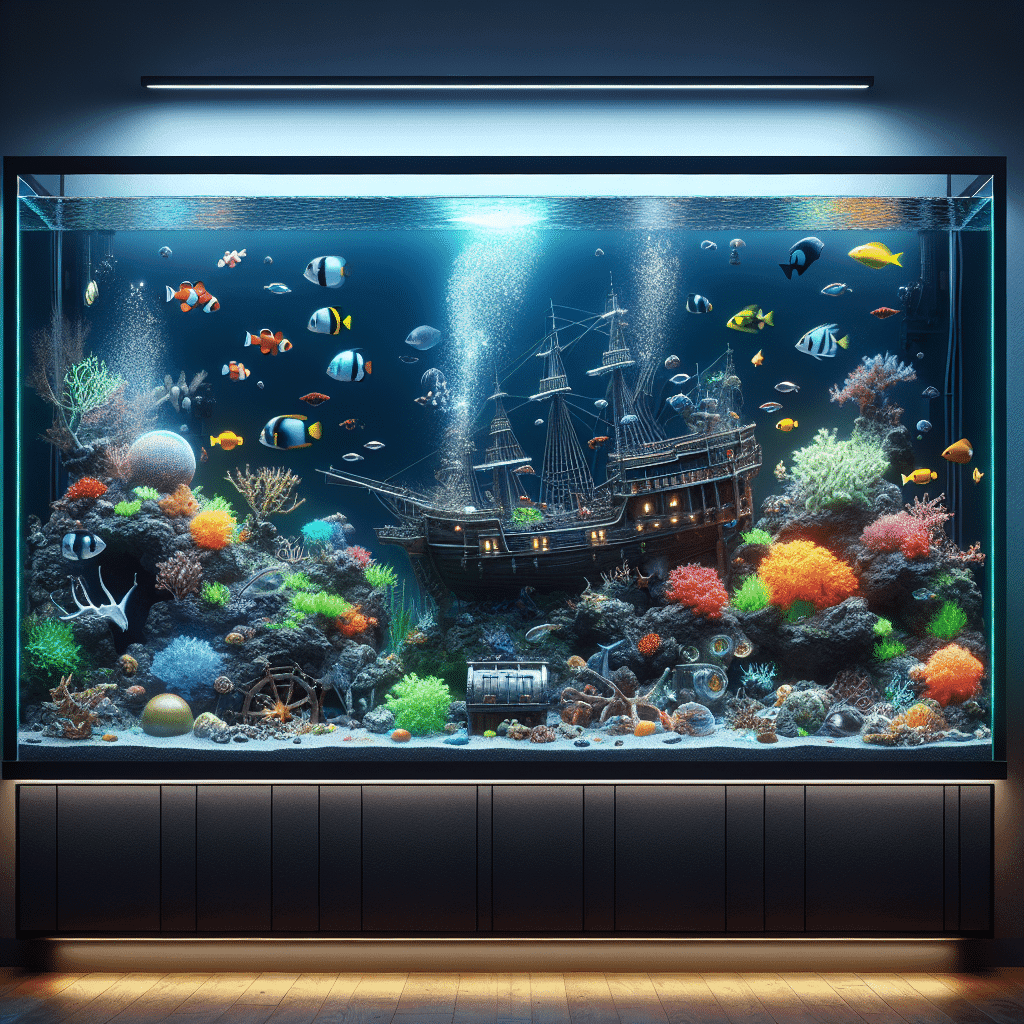Understanding Fish Habitat
As a fish tank and reef tank hobbyist, I find it fascinating to explore the differences between freshwater and saltwater ecosystems. Understanding these habitats is crucial, especially when considering the impact of introducing freshwater fish in saltwater environments.
Freshwater vs. Saltwater Ecosystems
Freshwater ecosystems, such as lakes, rivers, and ponds, are characterized by low salt concentrations, typically less than 1%. In contrast, saltwater ecosystems, including oceans and seas, have higher salinity, generally around 35 parts per thousand (ppt). This difference in salinity greatly influences the types of fish and other aquatic life that can thrive in these environments.
Here’s a quick comparison of the two ecosystems:
| Feature | Freshwater Ecosystems | Saltwater Ecosystems |
|---|---|---|
| Salinity | < 1% | ~35 ppt |
| Common Fish Species | Trout, Catfish, Bass | Clownfish, Angelfish, Tuna |
| Habitat Types | Lakes, Rivers, Ponds | Oceans, Coral Reefs, Estuaries |
| Nutrient Availability | Generally higher in nutrients | Nutrient cycling varies |
Essential Fish Habitat (EFH)
Essential Fish Habitat (EFH) is a crucial concept that refers to the aquatic habitats necessary for fish to spawn, breed, feed, or grow to maturity. While EFH applies to many marine species, it does not cover strictly freshwater species, such as lake trout. This is because EFH focuses on federally managed fish and invertebrates, which are not limited to enclosed freshwater habitats like the Great Lakes (NOAA Fisheries).
Understanding EFH is vital for responsible aquarium keeping. It helps ensure that the habitats we create in our tanks meet the needs of the fish we choose to keep. The identification and mapping of EFH locations help protect marine fisheries and vital habitats by minimizing or avoiding environmental impacts. These considerations are particularly important for species that cross regional boundaries, such as sharks and tuna (NOAA Fisheries).
In summary, grasping the differences between freshwater and saltwater ecosystems, as well as the importance of EFH, enriches my understanding and enhances my experience as an aquarium hobbyist. It helps me create a more suitable environment for my aquatic friends while avoiding potential pitfalls when considering species compatibility. For more insights on setting up a marine environment, check out our guide on saltwater aquarium setup.
Adaptations of Euryhaline Species
Understanding how certain fish can thrive in both freshwater and saltwater environments is truly fascinating. These remarkable creatures are known as euryhaline species, and they possess unique adaptations that allow them to survive in a variety of salinities.
Survival in Various Salinities
Euryhaline fish can withstand a wide range of salinity levels during different phases of their life cycles. For example, salmon typically spend a brief period in freshwater before transitioning to marine environments. During this time, they develop the ability to osmoregulate, enabling them to adapt to the saline conditions of the ocean (Scientific American). This adaptability is crucial for their survival and plays a significant role in their migratory behaviors.
| Fish Species | Salinity Tolerance | Habitat Transition |
|---|---|---|
| Salmon | Fresh to Saltwater | Freshwater to Marine |
| American Eels | Fresh to Brackish | Freshwater to Saltwater |
| Striped Bass | Fresh to Saltwater | Estuaries to Ocean |
| Bull Sharks | Fresh to Saltwater | Rivers to Coastal Waters |
Examples of Euryhaline Fish
Several species exemplify the incredible adaptability of euryhaline fish. Salmon, for instance, migrate from freshwater to the ocean, spending most of their lives in saltwater. Some species of salmon, like pink salmon, even head to the sea shortly after hatching (Scientific American).
American eels are another great example; they are born in the ocean but migrate to freshwater rivers and lakes to live. Eventually, they return to the ocean to spawn, completing their life cycle.
Bull sharks are particularly interesting because they can thrive in both freshwater and saltwater. They possess the ability to retain salt when entering freshwater environments, utilizing their kidneys, gills, and specialized rectal glands to adjust to varying salinity levels (Ocean Conservancy).
Striped bass, native to the North Atlantic coastline, also display euryhaline characteristics. They spend time in estuaries and migrate to the ocean, playing a vital role in their ecosystems by regulating prey populations and generating economic benefits along the coast.
By understanding these adaptations, I can appreciate the incredible capabilities of euryhaline species and their importance in both freshwater and saltwater ecosystems. If you’re interested in setting up a saltwater aquarium, be sure to check out our guide on saltwater aquarium setup to learn more about creating the perfect environment for your aquatic friends!
Osmoregulation in Fish
Understanding how fish maintain osmotic balance in different environments is crucial, especially when considering the topic of freshwater fish in saltwater. Let’s dive into the fascinating world of osmoregulation!
Osmotic Balance in Freshwater
In freshwater environments, fish face a unique challenge. They are surrounded by water that is less salty than their blood, which has a salinity of about 9 grams per liter (0.9 percent salt solution) (Scientific American). This creates a situation where water continuously flows into their bodies. To combat this, freshwater fish have evolved several mechanisms:
- Dilute Urine Production: Freshwater fish produce large volumes of dilute urine that is low in salt content. This helps them expel the excess water that enters their bodies (Scientific American).
- Salt Absorption: They actively absorb salts through their gills to maintain the necessary concentration of salts in their blood.
| Mechanism | Description |
|---|---|
| Urine Production | Large volumes of dilute urine to expel excess water |
| Salt Absorption | Active absorption of salts from the surrounding water |
Osmotic Balance in Saltwater
On the flip side, saltwater fish face the opposite challenge. They live in an environment with a higher salinity than their blood. This causes water to flow out of their bodies, leading to dehydration. To survive in this salty environment, saltwater fish have developed the following adaptations:
- Concentrated Urine: Saltwater fish produce concentrated urine to retain as much water as possible. This reduces the amount of water lost (Quora).
- Salt Excretion: They have specialized cells in their gills that actively excrete excess salts, helping to balance their internal salinity.
| Mechanism | Description |
|---|---|
| Urine Concentration | Producing concentrated urine to minimize water loss |
| Salt Excretion | Specialized cells in gills to expel excess salts |
Understanding these mechanisms is vital for anyone managing an aquarium. It helps ensure that the fish thrive in their environments, whether freshwater or saltwater. For more insights on successful tank setup, check out our guide on saltwater aquarium setup or learn about water changes for maintaining optimal conditions.
Unique Abilities of Diadromous Fish
Diadromous fish possess some of the most fascinating adaptations in the aquatic world. They can thrive in both freshwater and saltwater environments, and their life cycles are nothing short of incredible. Let’s dive into the unique life cycles of two prominent diadromous species: salmon and American eels.
Salmon: Anadromous Life Cycle
Salmon are anadromous fish, which means they hatch in freshwater, migrate to the ocean to mature, and then return to freshwater for breeding. This remarkable journey showcases their ability to adapt to varying salinities throughout their lifecycle. Salmon have evolved complex strategies, such as osmoregulation, to adjust between different aquatic environments during their migratory patterns (Ocean Conservancy).
| Stage of Life | Habitat | Key Characteristics |
|---|---|---|
| Hatchling | Freshwater | Begin their lives in rivers and streams. |
| Juvenile | Freshwater | Grow in freshwater, feeding on insects and small fish. |
| Adult | Saltwater | Migrate to the ocean, where they mature and gain size. |
| Spawning | Freshwater | Return to natal streams to spawn, completing their life cycle. |
American Eels: Catadromous Life Cycle
In contrast to salmon, American eels are catadromous. They are born in saltwater but spend most of their lives in rivers before migrating downstream to the sea to spawn. This fascinating lifestyle allows them to form symbiotic relationships with other species, such as freshwater mussels, contributing to the health and biodiversity of ecosystems (Ocean Conservancy).
| Stage of Life | Habitat | Key Characteristics |
|---|---|---|
| Spawning | Saltwater | Spawn in the Sargasso Sea, where their lifecycle begins. |
| Glass Eel | Freshwater | Juveniles migrate to freshwater, known as glass eels due to their transparent bodies. |
| Yellow Eel | Freshwater | Spend most of their adult lives in rivers or lakes, growing and maturing. |
| Silver Eel | Saltwater | Mature eels migrate back to the ocean to spawn, completing the cycle. |
These unique adaptations allow both salmon and American eels to navigate between freshwater and saltwater, making them truly special in the aquatic realm. Understanding these life cycles can enhance my appreciation for the diversity of fish and the complexities of their environments. If you’re interested in setting up a habitat for these amazing fish, check out our guide on saltwater aquarium setup and learn how to maintain optimal conditions.
Health Risks in Central Asia
Toxic Metals in Aquatic Environments
In Central Asia, the presence of toxic metals in aquatic environments poses serious health risks to both fish and humans. Common heavy metals like arsenic (As), mercury (Hg), cadmium (Cd), and lead (Pb) are often found in these waters, leading to significant contamination. These metals can enter aquatic systems from both natural sources and human activities, accumulating in fish and other aquatic organisms. It’s alarming to learn that high levels of these toxic metals have been detected in the blood of children and pregnant women living near the lower Amu Darya Basin, leading to various health issues (NCBI).
| Toxic Metal | Common Sources | Health Risks |
|---|---|---|
| Arsenic (As) | Agricultural runoff, industrial waste | Skin lesions, cancer, developmental issues |
| Mercury (Hg) | Mining, industrial discharge | Neurological disorders, cognitive impairments |
| Cadmium (Cd) | Battery production, industrial discharge | Kidney damage, bone fragility |
| Lead (Pb) | Old pipes, industrial emissions | Developmental delays, cognitive deficits |
Impact on Human Health
The impact of toxic metals on human health in the region is profound. Consumption of contaminated fish and seafood can lead to severe health problems, particularly in vulnerable populations like children and pregnant women. Reports indicate that high infant mortality rates, low birth weights, growth retardation, and acute respiratory diseases are prevalent in areas affected by these contaminants. Even though fish and seafood consumption in Central Asia is below recommended levels, those living in regions with higher fish intake face increased exposure to these toxic metals, especially mercury.
It’s crucial for aquarium hobbyists and fish enthusiasts to be aware of these issues when considering the health of fish in their tanks, especially if they are sourcing their fish from areas affected by these contaminants. Regular monitoring of water quality and ensuring a safe environment for fish is essential. For more tips on maintaining a healthy aquatic environment, check out our guides on water safety, aquarium maintenance, and water changes.
Salinity Adaptation in Fish
Maintaining the right salinity is essential for fish health, especially when considering the fascinating world of keeping freshwater fish in saltwater environments. As I dive into this topic, I find it exciting to explore how different fish cope with varying salinity levels!
Coping Mechanisms in Freshwater Fish
Freshwater fish face unique challenges in saltwater environments. These fish naturally produce large volumes of dilute urine that is low in salt content. This adaptation allows them to retain essential salts in their bodies. However, when placed in saltwater, their bodies struggle to flush out the excess salts they inadvertently absorb.
Here are some key coping mechanisms of freshwater fish:
| Adaptation | Description |
|---|---|
| Dilute Urine Production | Freshwater fish excrete a lot of dilute urine to conserve salts in their bodies. |
| Kidney Function | Their kidneys are less stressed in low salinity waters, as they don’t need to expel excess salts. |
| Behavioral Changes | Some may seek brackish environments to gradually adapt to changing salinities, such as estuaries. |
Freshwater fish often cannot survive in saltwater because they cannot effectively manage the influx of salts, leading to dehydration and potential fatality (Quora).
Coping Mechanisms in Saltwater Fish
On the other hand, saltwater fish have evolved several fascinating adaptations to thrive in their saline environments. They are generally better equipped to deal with the higher levels of salinity found in oceans.
Key adaptations of saltwater fish include:
| Adaptation | Description |
|---|---|
| Concentrated Urine Production | Saltwater fish produce urine that is highly concentrated to expel excess salts. |
| Gills for Salt Excretion | Their gills can actively excrete excess sodium and chloride ions, helping to maintain osmotic balance. |
| Drinking Water | They actively drink seawater to replace lost water, using specialized cells in their gills to filter out excess salts. |
Fish that transition between freshwater and saltwater, like salmon, often make physiological adjustments in brackish estuarine environments to prepare for these changes. This adaptability is crucial for their survival and success in varying habitats.
Understanding these mechanisms is vital for anyone interested in setting up a saltwater aquarium setup or exploring the complexities of fish care. It highlights the importance of maintaining the right environment and salinity levels to ensure the health of the fish in my tank.
Microplastic Contamination in Fish
As a fish tank enthusiast, I find it essential to understand the impact of microplastics on both freshwater and marine fish. Let’s dive into the sources and types of microplastics found in our aquatic environments, as well as the prevalent plastic polymers that can affect the health of our fish.
Sources and Types of Microplastics
Microplastics are tiny plastic particles less than 5mm in size that can originate from various sources. In freshwater ecosystems, the predominant types of microplastics found in fish include fibers, microbeads, fragments, foams, and films. Marine fish also show a similar trend, with fibers being the most common, followed by fragments, films, microbeads, and foams.
Here’s a breakdown of microplastic types found in both freshwater and marine fish:
| Microplastic Type | Freshwater Fish | Marine Fish |
|---|---|---|
| Fibers | Dominant | Dominant |
| Fragments | Less common | Common |
| Films | Less common | Common |
| Microbeads | Present | Less common |
| Foams | Present | Present |
The dominant colors of microplastics found in both environments are black and blue, with sizes typically less than 500 µm to 1 mm (Wiley Online Library).
Plastic Polymers in Freshwater and Marine Fish
The types of plastic polymers present in our fish can vary significantly between freshwater and saltwater environments. In freshwater fish, the most prevalent polymer recorded is polyethylene terephthalate (PET), while in marine fish, polyethylene (PE) takes the lead. These differences can be attributed to human activities and the specific environmental contaminations at the sampling locations.
| Plastic Polymer | Freshwater Fish | Marine Fish |
|---|---|---|
| Polyethylene Terephthalate (PET) | Common | Rare |
| Polyethylene (PE) | Rare | Common |
Understanding the presence of these microplastics and polymers is crucial for maintaining a healthy aquarium environment. By being aware of potential sources and types of contamination, I can better manage my tank and protect the aquatic life within it. For more information on maintaining a healthy reef setup, check out our guide on saltwater aquarium setup and learn about water safety practices to ensure the well-being of your fish.
Human Impact on Aquatic Environments
As I dive deeper into the realm of marine aquariums, I can’t ignore the influence that human activities have on aquatic habitats. Understanding the pollution indices and contamination levels in both freshwater and saltwater environments is crucial for any hobbyist.
Pollution Indices and Contamination Levels
Pollution indices are essential for gauging the health of aquatic ecosystems. A review involving 345 marine and 77 freshwater fish species across 17 Asian countries revealed alarming levels of contamination. Notably, China reported the highest number of contaminated species in both freshwater and marine environments.
Here’s a summary table of the number of contaminated species across different environments:
| Environment Type | Number of Contaminated Species |
|---|---|
| Marine | 345 |
| Freshwater | 77 |
| Total | 422 |
Omnivorous and carnivorous fish show a higher susceptibility to ingesting microplastics (MPs). Certain habitats, such as benthopelagic, demersal, and reef-associated areas, are significantly more prone to MP accumulation in both types of environments.
Factors Contributing to Plastic Pollution
Plastic pollution is a pressing issue affecting the health of our aquatic ecosystems. The review identified that specific fish species, including Clarias gariepinus in freshwater and Selaroides leptolepis in marine environments, exhibited the highest levels of MP contamination (Wiley Online Library).
Understanding these factors helps me better manage my own aquarium setup. Some contributing factors include:
- Overreliance on single-use plastics: Excessive use of plastic products leads to more waste entering aquatic systems.
- Improper waste disposal: Inadequate disposal methods can result in plastics ending up in waterways.
- Aquaculture practices: Some practices can contribute to microplastic pollution, affecting fish health and ecosystem balance.
Being aware of these influences allows me to make informed decisions about how I maintain my tank and care for my fish. For tips on keeping your aquarium safe and healthy, check out our articles on water safety and aquarium maintenance.



